
Two weeks ago, I wrote about how speculation opportunities in Standard have been drying up due to the increasing size of Magic’s player base. There’s still money to be made if you know where to look, though, and Core Sets are always your best bet. These yearly expansions benefit from financial advantages that normal sets do not have, and you can use that to your advantage. Consider:
Draft interest is low. Some Core Sets (like M11) are very good Limited formats. As a rule, though, Core Set drafting is both simpler and less exciting than playing with cards from the normal expansions. Weekly FNM grinders are still going to turn out to draft every week regardless, and a small number of players do prefer the ‘pure’ experience of Core Set draft, but the overall numbers don’t lie. Tournament attendance dips from July through early September, and Core Set sales flag below the well-marketed expansions. Less product opened means fewer available singles.
This effect may be less pronounced than usual this summer, though. If you believe the internet hype, M15 is the most anticipated and well-reviewed Core Set since M10 and it should sell better than the last few.
The draft window is short and the set is large. Core Set drafts are only the weekly FNM format from mid-July through mid-September. That’s two short months. That’s about the same as the spring set but significantly shorter than both the winter and fall set each year. Core Sets are much larger in size than the spring and winter sets, too, which makes each individual card significantly less likely to get opened.
Summer Standard is a lame duck format. Tournament players are always innovating, to be sure, but most amateurs and PTQ grinders have sold out of their Standard staples already and are patiently awaiting the fall expansion. This means that fewer people are attempting to figure out which M15 cards are positioned to dominate Standard each week. Some powerful Core Sets cards always slip through the cracks and shoot up in value later on.
Boring cards are underrated. Splashy, mechanic-defining creatures and spells are the most overrated cards in Magic. Casual planeswalkers and narrow but powerful mythics like Athreos (whoops!) always start high, but they end up dropping in price quick if they don’t end up as a four-of in the format’s best deck. Core Sets tend to have a higher percentage of ‘glue’ cards – spells, creatures, and lands that aren’t flashy but can end up defining a format. These are the cards that everyone on the floor needs right before an event and are often the best speculation opportunities.
Cards that pre-order at absurdly high prices are usually expensive because of their perceived potential. Athreos could have been the next Jace, which is why he started at $30. We all knew exactly how good Mutavault was going into M14 previews last summer, though, so it slipped in under the radar at $15. If you were paying attention, you might have realized that a land that thoroughly dominated Standard for two full years last time around would likely still be very good. ‘Boring’ usually just implies access to additional information. Use it.
So – are there any gems lurking in M15? I’ll be covering the set extensively over the next few weeks, starting today with the mythic rares. Let’s begin with the most expensive and anticipated card in M15:
Garruk, Apex Predator – $30
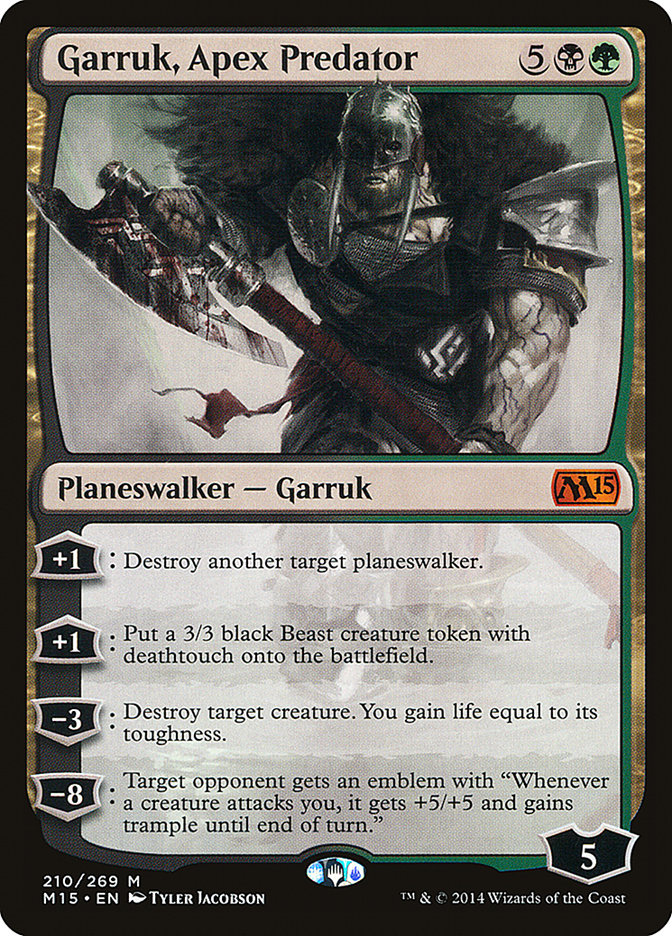
Here is a list of things that always seem to be overvalued:
1) Planeswalkers
2) Expensive Planeswalkers
3)Gold Planeswalkers
In order for Garruk, Apex Predator to maintain its $30 price tag, there will need to be a Standard ramp deck that can support a very expensive G/B card. That deck will have to be top tier, and it will have to play at least two or three copies of Garruk in the main. I can see it happening, but I don’t think it’s terribly likely.
If the new Standard format brings us a slow, planeswalker-based form of Magic similar to what we saw at Pro Tour Journey Into Nyx, I can see Garruk thriving. His abilities are terrific. He can deal with any creature or planeswalker immediately, and if you’ve got an empty board or have already established control, Garruk will sit around making versatile two-way threats until you can Overrun for the win.
Even if Garruk does not become a major player in the new Standard, he’s likely to hold most of his value due to casual demand. Nicol Bolas, Planeswalker was a $20 card before it was reprinted in M13 exclusively because of casual players, so don’t underestimate Magic’s largest audience. Garruk doesn’t have the same raw power as Nicol Bolas, but he is much easier to cast. The fact that he’s a large part of the lore and marketing for the set will help buoy his price as well.
According to Ben Bleiweiss’ article series, sales demand for the new Garruk has been very high, so I wouldn’t expect an immediate drop in price if he doesn’t make an impact in Standard. Most of the expensive mythics in Core Sets tend to keep their value for a month or more before finally succumbing to waning interest thanks to exciting cards being spoiled from the fall set. Kalonian Hydra was last year’s $30 casual beast, and even though he’s just $10 now his price tag was still over $20 at the start of October last year. I wouldn’t be shocked if Garruk stays in the $25-$35 for longer than you might think, regardless of how much (or how little) competitive play he sees.
If Garruk does end up being a major player in Standard, the fact that he has four abilities could cause the masses to shout “It’s the next Jace!!” and rocket his price above $50 in the short term. This is an unlikely scenario, but it’s not totally out of the question and could lead to a nice short-term spec opportunity. If Garruk shows up in a couple of winning decks during the first week or two of format legality, I’m buying in for the quick flip. Otherwise, I’m staying far away from Garruk – his decline is likely to be both long and slow.
Nissa, Worldwaker – $25
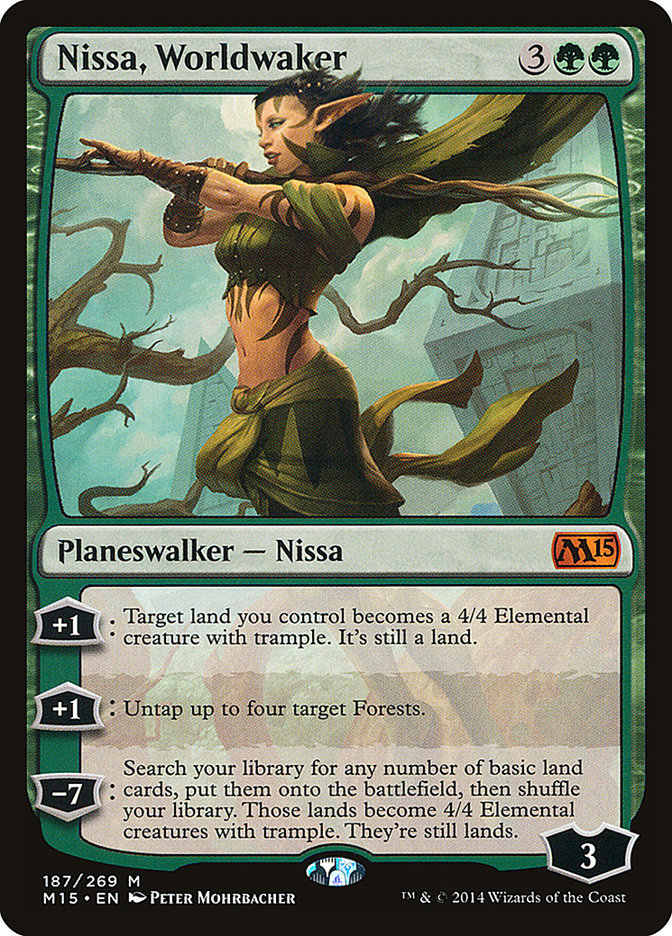
I don’t know much about planeswalker lore, but is Nissa dating Koth? If not, can we introduce them? I feel like they’d get along famously, considering how similar their abilities are.
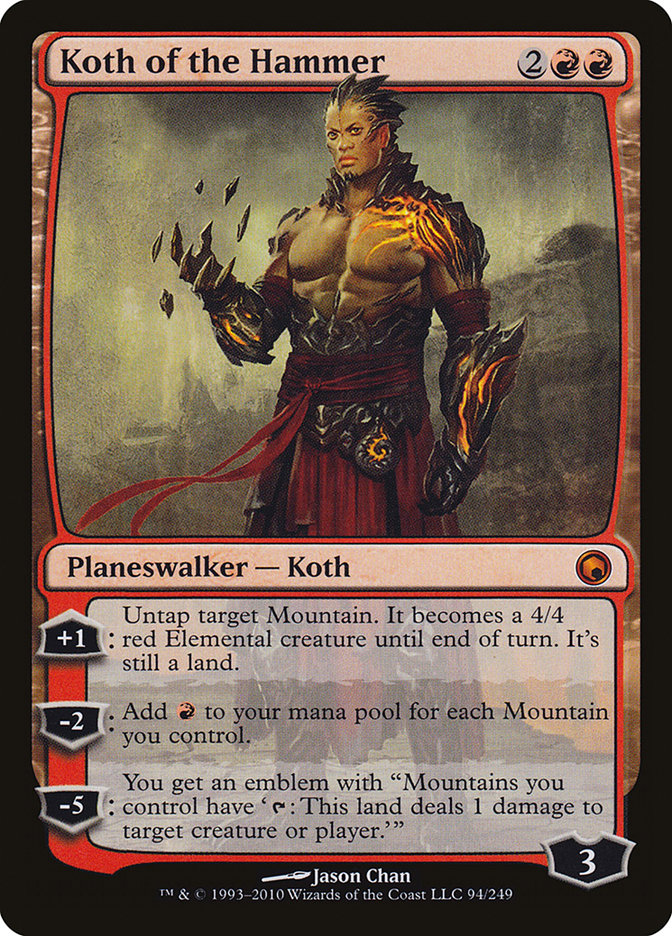
Seriously – two peas in a pod, right? That’s good news for us, because Koth was pretty good in Standard and I expect Nissa to follow suit. She costs one more, but her Elementals stick around after the end of your turn, she’s in a better color for ramping, her second ability helps her loyalty, and her ultimate is far more likely to end the game than Koth’s.
Even though Koth and Nissa have a lot in common, I’d be surprised if they are played in similar ways. Koth usually came out on turn four and made a Mountain attack right away. Nissa will also come out on turn four a lot of the time, but I’d expect the most common play will be untapping four Forests and playing another threat. The fact that this ticks Nissa up to four while giving you the ability to generate extra mana or a threat the next turn makes her quite a strong play.
$25 is close to Nissa’s ceiling, but she’s one of the safer mythic pre-orders out there. I expect her to be a strong player in the new Standard, and the only way I can see her staying on the sidelines is if the next block strongly discourages playing Forests over, say, a full complement of scrylands and pain lands.
Whatever deck runs Nissa will likely want 2-3 copies of her, which has historically translated into a long-term value between $15-$20. The fact that Nissa is in a Core Set and has strong casual demand could mean a price tag more in the $25-$35 range, however, at least over the short-term. If Nissa doesn’t end up in Standard at all, her floor is $10-$12, but she won’t drop that far until late September at the earliest. If you open Nissa at the prerelease, you’ll have plenty of time to see how the format shakes out before you need to pull the trigger on a trade. Garruk is the more exciting planeswalker, but I’d bet Nissa ends up being the better value and the more impactful tournament player.
Ajani Steadfast – $20
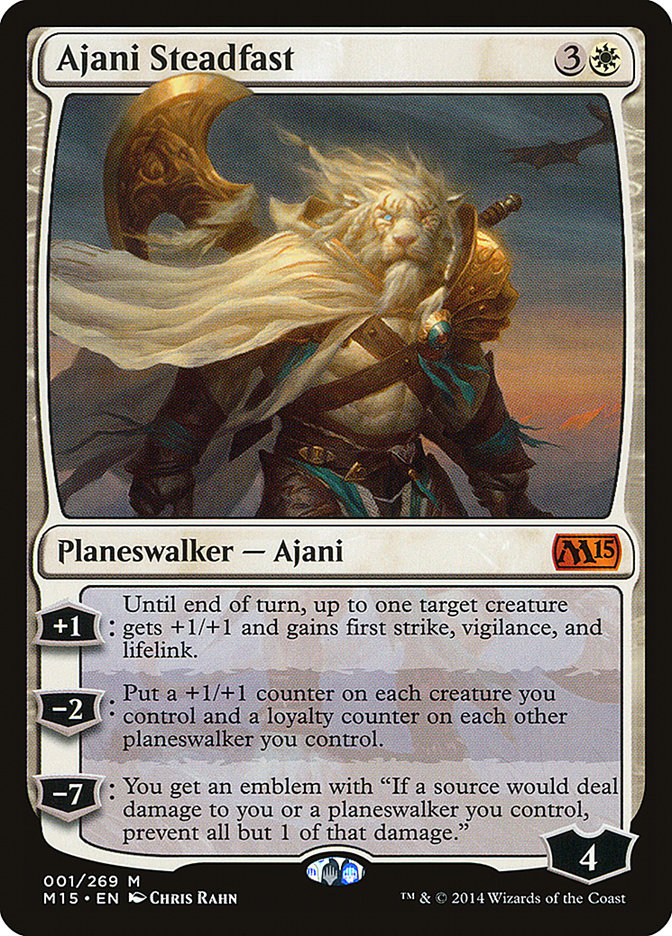
I love how all of Ajani’s cards play right into his character. He’s all about helping people out, so he’s only good when he’s got enough friends around. Fittingly, this means that Ajani’s fate lies in whether or not he’ll find a home in the Bant Planeswalker deck and whether or not that deck will end up being in the new Standard format.
The problem with Ajani is that his abilities pull you in three different directions. His first ability is best when strengthening a single creature that is already fairly big. His second wants you to have a large weenie army and a couple of other planeswalkers. How often will more than one of these things be true? Also, how often will you topdeck him while staring at an empty board?
Ajani is at his best when he’s helping Elspeth buff her tokens and ramp toward her ultimate. If you’ve got her on the battlefield, though, aren’t you already winning? Ajani is undeniably powerful in the right situation, but he’s both a classic win-more card and a poor topdeck. Ultimately, I think that Ajani Steadfast will see only minimal Standard play and will be under $10 by the beginning of winter.
Jace, the Living Guildpact – $20
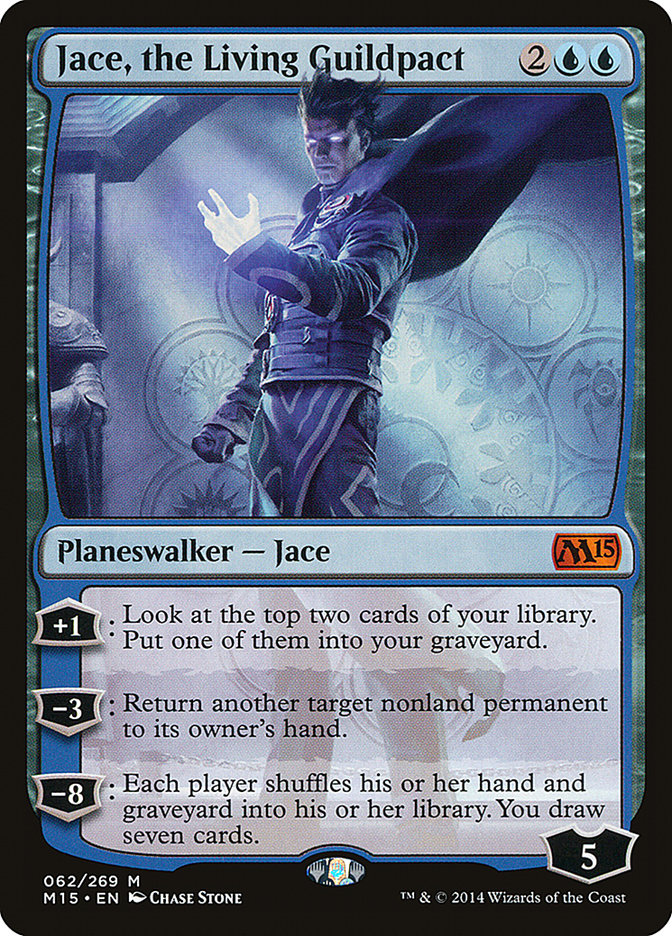
Let’s be honest here: Jace is $20 based solely on name value. If Jace, the Living Guildpact had been called Shlubb, The Confused Scryer instead, he’d be starting out at $10, right?
Public reaction to this version of Jace has been interesting. At first, people were incredibly disappointed because of how poorly The Living Guildpact compares to previous iterations of Jace. Then came the backlash to the backlash, where players started ranting about how Jace, TLG is actually much better than he looks.
The truth is probably somewhere in the middle. Jace, The Living Guildpact is playable, but his power level is lower than at least three of the other Jaces. Card filtering is an underrated ability, and Jace’s +1 is being overlooked mostly because it compares poorly to Scry 2, but it’s still only really comparable to drawing a card during the late game of a control matchup. Jace’s -3 is going to be the better part of a Time Walk against midrange decks, and his ultimate is both very good and very achievable, but he’s going to sit around and do nothing a lot of the time as well.
Jace will see some play in Standard, but I don’t think he will dominate. He’ll come out of the sideboard against control decks – something that will make him worth at least $8-$10 – but beyond that, I don’t know if he’ll find a home. It’s possible that we’ll end up in a control-heavy Standard environment next season, which would mean Jace could shine as a significant maindeck threat, but I don’t think that’s terribly likely to occur. What’s more likely is that he will ebb and flow in value depending on the metagame, spiking back toward $15-18 on the tournament floor whenever it looks like he might be able to make a strong impact. I’m a seller at $20.
Chandra, Pyromaster – $8
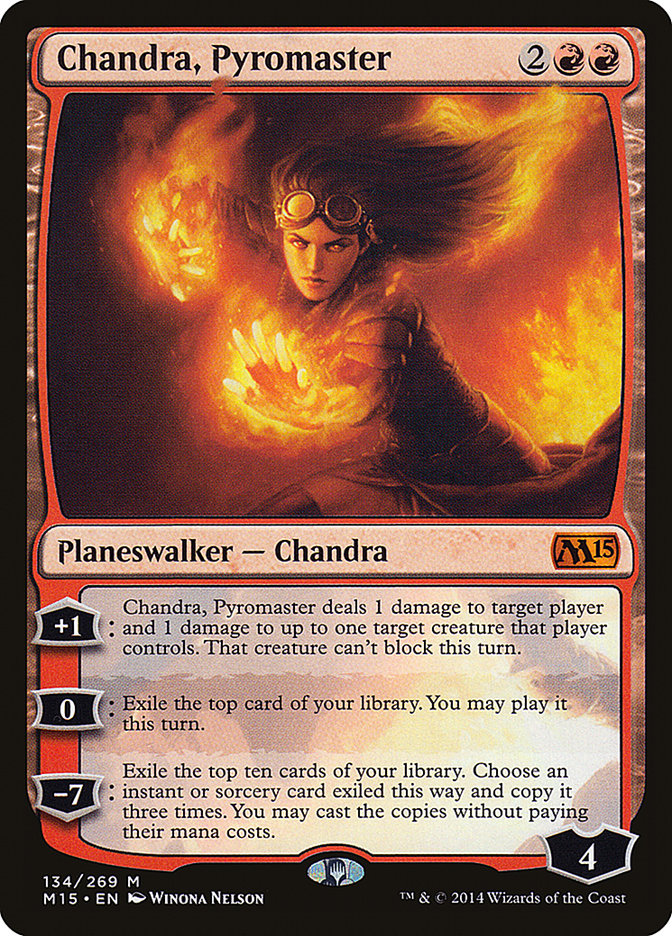
Chandra was the other chase mythic from M14, and for the first month or so of her Standard legality it looked like she was going to become one of the most important cards in the format. Interest in the red planeswalker fell off a bit after that, and her price has been slowly dropping ever since.
A stroll through the decklist database shows us that Chandra is still a very important part of Standard, however. She’s a singleton out of the sideboard of many RG and RUG decks, and several red brews are running 2-3 copies of her in the main. Overall, she sees more play than most planeswalkers right now.
Interest in Chandra is low right now thanks to the reprint, and you’ll probably be able to pick copies up in trade for $5 or so during the weeks after M15 hits stores. Your risk level in doing so will be close to zero over the next year – she’s not going any lower than that. Even if she just continues to see a similar level of play going forward, she’ll rebound to $10 or $12 in the spring simply due to dwindling supply. If the metagame breaks right, though, she has just as much of a chance of dominating as any of the planeswalkers higher than her on this list right now. I like her has a boring sleeper opportunity.
Liliana Vess – $8
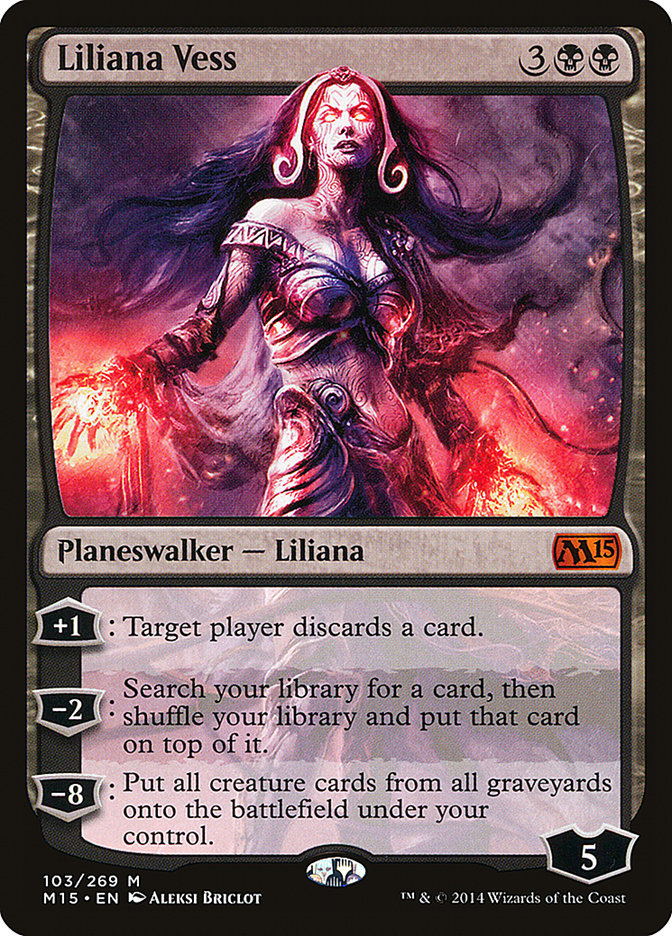
According to Mark Rosewater, Liliana of the Veil was in the design file until development nixed it. Apparently, they thought the card would be too strong for Standard right now, which was probably true. Instead, we’ve got Liliana Vess for the sixth time. What fun!
Liliana Vess is unlikely to make any more of an impact this time around, and I’d expect her value to stabilize in the $4-$5 range. There’s nothing to see here, folks. Move along.
Soul of New Phyrexia – $15
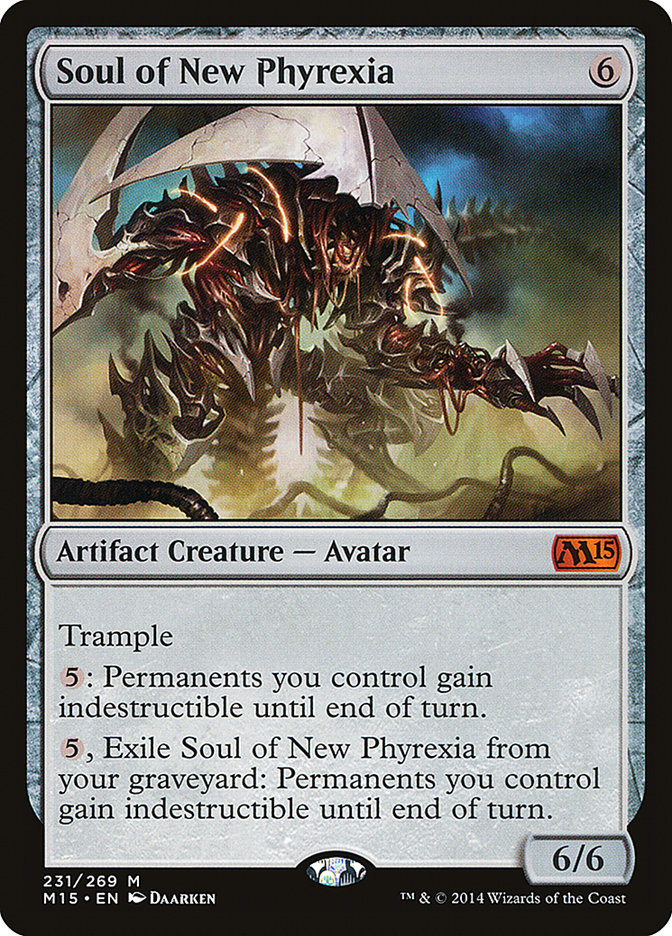
Soul of New Phyrexia is a very good Commander card. It’s close to a must-play in any deck dedicated to ramping, allowing you to save your army from most sweepers if you’ve got the mana. The fact that it works a second time from the graveyard is great, too. I will be adding this to both of my big, angry green decks.
I don’t see Soul of New Phyrexia making much of an impact in Standard, though. This is no Wurmcoil Engine, and a 6/6 for six mana with trample that does nothing unless you hold up a ton of mana isn’t going to make the cut. It’s possible that the ‘from the graveyard’ cycle of abilities are better than I’m giving them credit for right now, but I have a hard time recommending that you buy any creature this expensive that doesn’t make an impact the turn it comes down. Soul of New Phyrexia requires you to have access to eleven mana immediately if you want to protect it the turn you play it, and that seems unfeasible to me. It might see some fringe play in certain matchups, but that’s about it.
Soul of New Phyrexia probably does have long term value in the $10-$15 range thanks to Commander interest, but I think that the price will drop considerably once people realize that this isn’t much of a competitive card. Look to pick these up for $5 next spring and stick them in your long-term spec box.
Soul of Theros – $10

The good news for Soul of Theros is that I like it more in Standard than Soul of New Phyrexia. It still does nothing when you play it, but if it gets killed it can still Overrun your team from beyond the grave. That’s an ability that must be respected.
The bad news here is twofold, though. First off, Soul of Theros shares a casting cost with Elspeth, Sun’s Champion. It is possible that a deck may exist that wants to run this instead of Elspeth, but that card is going to be much more powerful in the vast majority of situations. Second, Soul of Theros’ activated ability is merely okay in Commander. Aggressive decks don’t work as well in that format, and most white-based Commander builds focus on building a large equipped attacker, not a gigantic army. White and G/W tokens decks will probably play one of these, but that’s about it.
In the right Standard format without Elspeth, I could see this being a $10 card. In this one, it’s a $3-$5 card with some long-term Commander upside.
Soul of Shandalar – $6
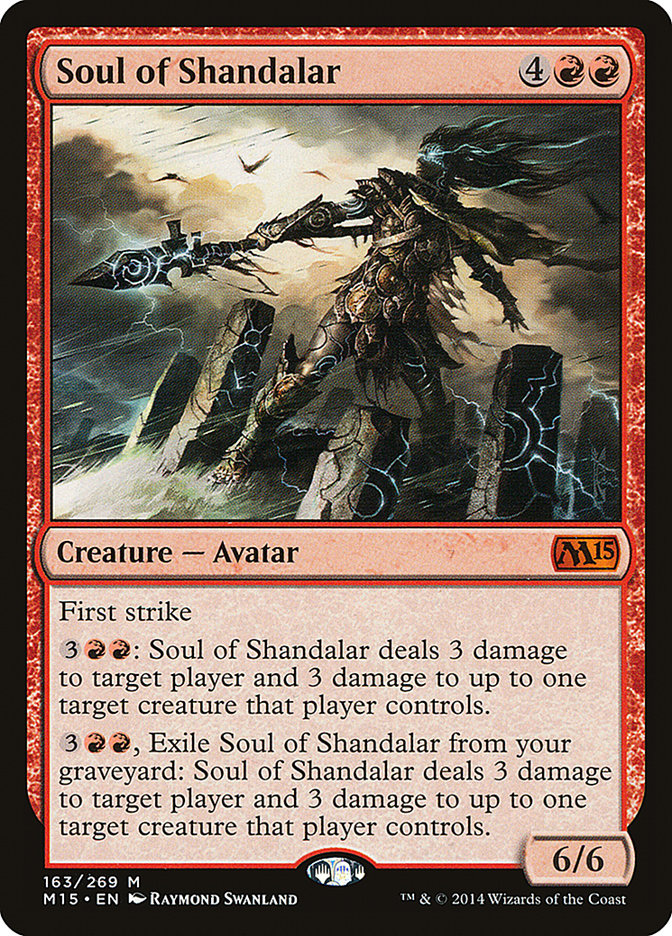
It’s hard to avoid comparing Soul of Shandalar to Inferno Titan. Titan did less damage, but its ability was free, immediate, and could potentially kill multiple creatures at once. Soul of Shandalar would be completely unplayable if it wasn’t for the graveyard ability, so like all of these ‘Titans’ it will sink or swim depending on how useful that clause ends up being. It’s essentially a free card, which is nice, but the free card is basically Starfall. Is it worth having to run a bad 6/6 for six mana in your deck just to have access to a free slightly-better Starfall whenever it dies? I doubt it, and thus I expect this to be a bulk mythic sooner rather than later.
In Commander, Soul of Shandalar is much worse than Inferno Titan. Very few people play Inferno Titan in their Commander decks as-is, so I doubt it will make an impact.
Soul of Innistrad – $5
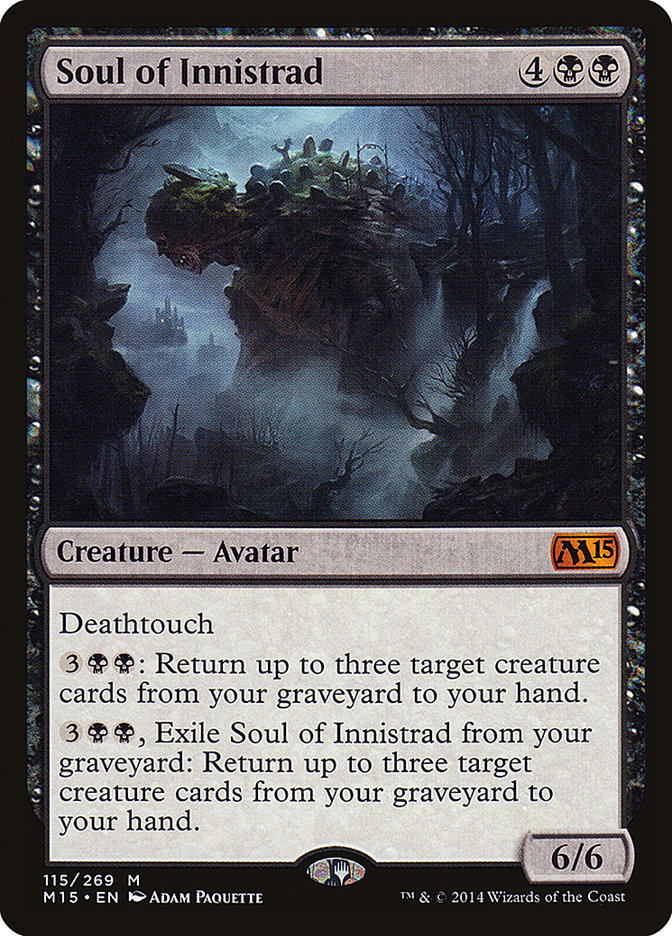
Soul of Innistrad is one of the more interesting members of this cycle. Black plays the best with graveyard shenanigans to begin with, and in Commander this card can be fetched up with Entomb or Buried Alive to help you cycle through your utility creatures. Deathtouch is also a strong ability in Commander, allowing you to go on the offense against anything or stay back and block something bigger.
I’m not sure black devotion decks want to get this big in Standard, though, so I still think this is a casual-only play. I like it long-term in the $3-$4 range – interesting graveyard cards rarely fall too far below that.
Soul of Zendikar – $5
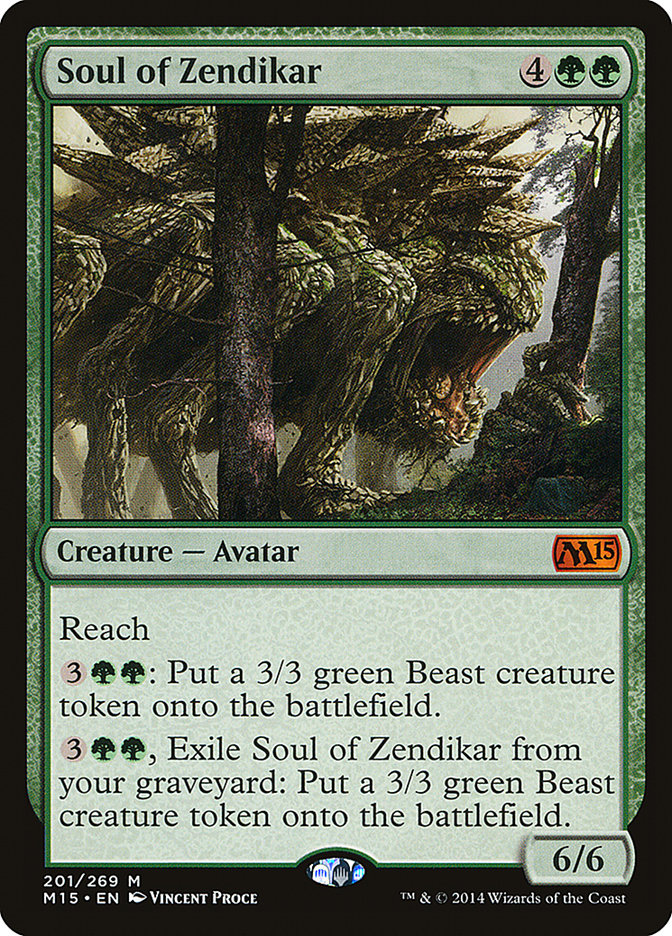
Soul of Zendikar is the Duels of the Planeswalkers promo for iPad, Steam, and Android, so there are going to be a lot of these out there. I’m not sure who the intended audience is for this card either. Commander players don’t really care about making 3/3s, and much like the rest of this cycle I don’t think the incremental card advantage gained from the graveyard ability is going to be worth the downgrade from better green monsters like Arbor Colossus and Polukranos. This is a bulk mythic.
Soul of Ravnica – $3
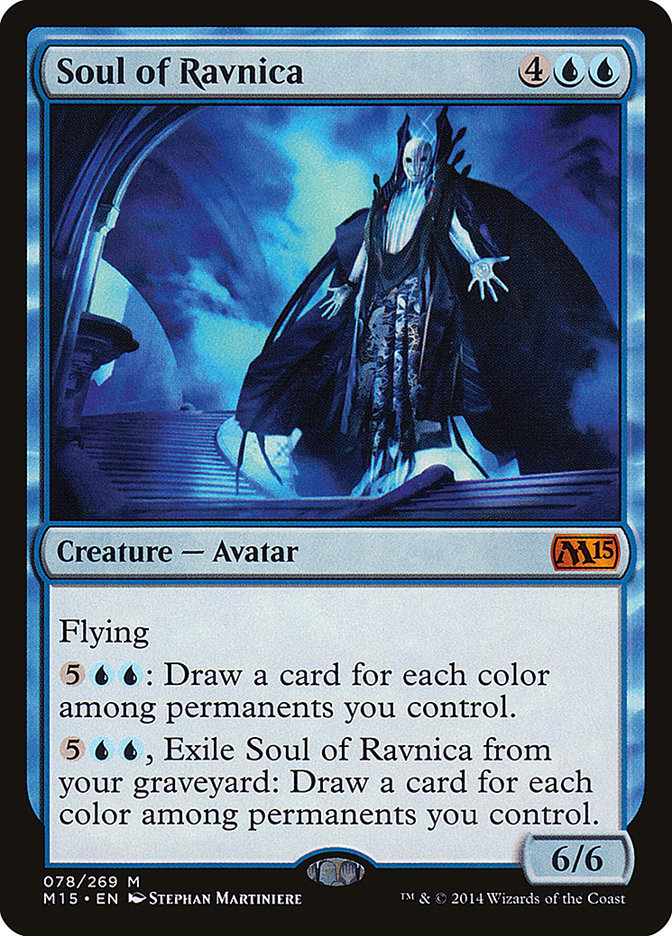
Soul of Ravnica is the promo for all Xbox versions of Duels of the Planeswalkers, so any sleeper value found here will be significantly diminished by the influx of free copies. That said, I’m kind of surprised that Soul of Ravnica is selling for so much less than Zendikar and Shandalar.
I’m not certain that Soul of Ravnica is a playable card in Standard – in fact, it’s probably not – but it certainly seems better than most of the others. Soul of Ravnica has the potential to draw a ton of cards at instant speed, which is far better than making a 3/3 or Starfalling someone. Seven mana is a lot, but it’s not out of the question for a UW or Esper-based control deck to go this deep. Sphinx’s Revelation is going to rotate soon, and while this is a major step down, it is a threat as well as a nice source of late-game card advantage. Soul of Ravnica is a decent play in Commander, too.
There is still downside at $3, of course, and the floor for this card is a $1.50 bulk mythic. If you’re looking for a really deep spec target, though, here you go. I’m pretty sure I’m the driver and sole passenger of the Soul of Ravnica hype train right now.
Sliver Hivelord – $15
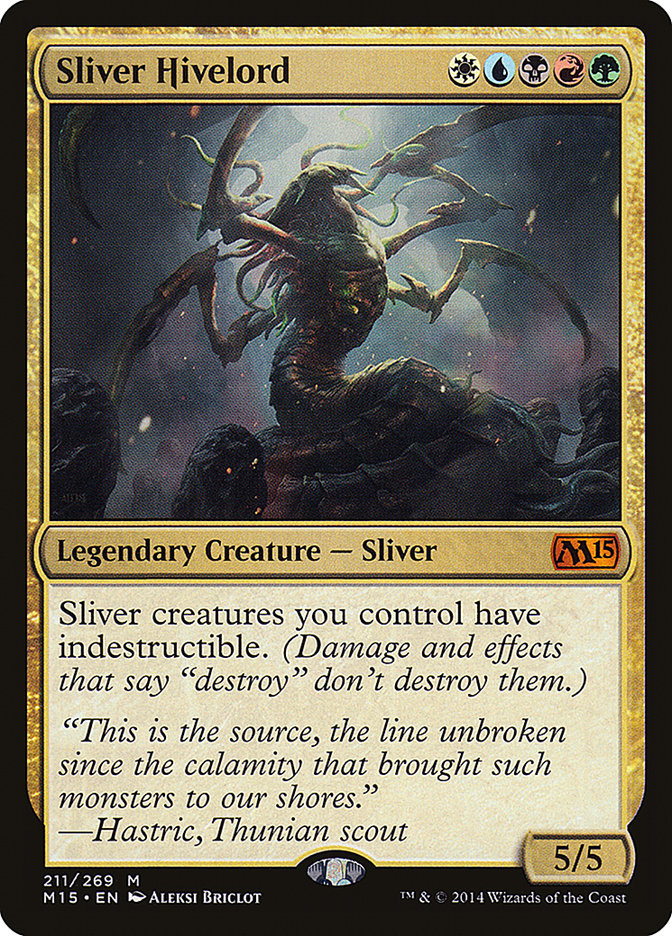
Sliver Hivelord is the fourth five-color Sliver lord, and its power level is comparable to the other three. Indestructible is in the running for the most-beloved casual keyword, and Slivers have long been one of the favorite casual creature types. This card may never appear in a tournament-winning decklist, but there will be strong demand for it regardless.
Long-term, $15 is probably the floor for Sliver Hivelord. It could go as high as $30 or $40 in the next couple of years if M15 doesn’t sell that well, though I’d expect a long term price closer to $20 or $25. Short-term is the more interesting question: how low can it go before M15 is off the shelves? When should we buy in?
Once the hype dies down, I’d expect Sliver Overlord to drop at least to $10 if not as far as $6-$8. It should rebound fairly quickly, though, and I wouldn’t wait past Christmas or so to buy in. These should be nice long-term trade targets as soon as next month if you’re looking to lock in value on the tournament floor.
Perilous Vault – $10
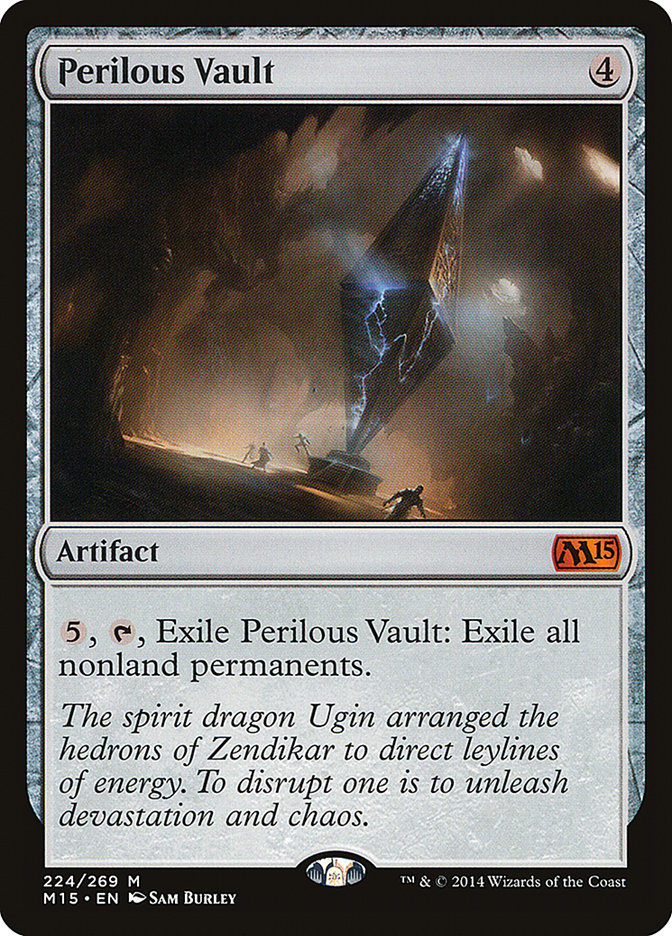
Long-term, Perilous Vault has something of a built-in price ceiling thanks to the existence of Oblivion Stone. Perilous Vault does exile cards instead of destroying them, but Oblivion Stone costs a mana less and interacts favorably with Wurmcoil Engine, which is important for the Tron decks that run the card. I doubt Vault will get the nod over Stone in Modern most of the time, and most Commander decks will simply play whichever of the two is cheaper to buy. The difference between the two isn’t that great.
How good will Perilous Vault be in Standard, though? Well, Supreme Verdict is rotating in September, so it’ll be unclear how important Perilous Vault will be to the format for the next few months. Fall may bring another tier-one sweeper on the level of Verdict, Wrath, or Damnation – it may not. If so, then the demand for this card will depend how easy it is to splash that sweeper and/or how badly the other colors want a way to wipe the board. Regardless of any other sweeper we might be getting, Perilous Vault might prove too slow and difficult to take advantage of if next year’s Standard is very fast. If it’s a slow format, however, this could be one of the defining cards of the next year.
If it feels like I’m being wishy-washy in my analysis here, it’s because Perilous Vault has the biggest metagame-dependent variance of any card in M15. It could be unplayable, it could be a multi-deck staple, or it could fall anywhere in between. More than any other card, we will need to sit back and see how things unfold.
If Perilous Vault does see significant Standard play it could hit $20-$30 quite easily. It’s a mythic rare utility player that can go in any deck, which means that it fits the profile for the kind of card that tends to be undervalued with significant upside. If it is a Standard afterthought, it is still good enough to stay in the $5-$8 range thanks to casual and Commander demand. I wouldn’t be surprised if this hits $15 at some point in the next few weeks as its price tag falls closer in line with its upside, and I’ll be monitoring it very closely going forward.
The Chain Veil – $5
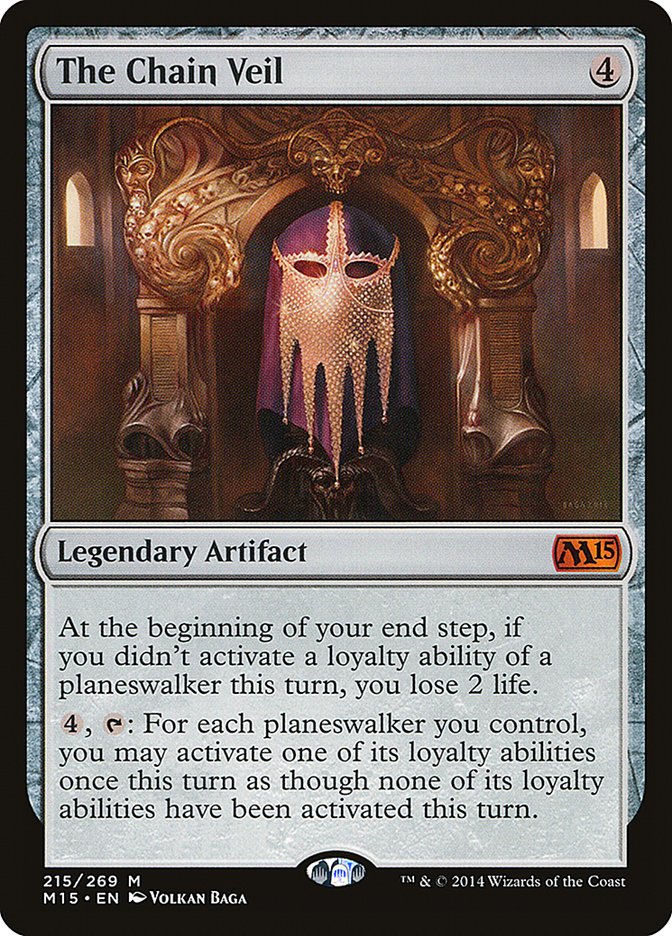
I don’t expect The Chain Veil to make an impact in Standard. Sure, it’s pretty great if you’ve got two or more planeswalkers out, but even still it costs eight mana before it even does anything at all. I’d rather play another planeswalker, and I’d put my money in Ajani Steadfast over this if a deck with tons of planeswalkers in it starts to dominate the metagame.
The Chain Veil likely going to be a popular one in casual circles, though, and it should slot well in Commander decks with multiple planeswalkers as well as 60-card casual brews. The Chain Veil certainly feels mythic, and if we don’t see it reprinted at any point soon, I’d expect it to go up in price significantly over the long term. If this drops toward $3, I’m buying in big and stocking up. This is an $8-$10 card in a couple of years.
This Week’s Trends
- I’ll be discussing the rares of M15 in depth next week, but for now I’d recommend selling all copies of cards that have been confirmed as reprints. That includes Chord of Calling, Preeminent Captain, Hornet Queen, Crucible of Fire, Phyrexian Revoker, Urborg, Tomb of Yawgmoth, and all of the painlands. It’s likely too late to get even half of the value you could have gotten last week, but I’d expect most of these cards to drop off even further. Chord of Calling and the $8-$10 painlands feel especially overpriced to me right now.
- Modern season is in full swing, yet Modern cards haven’t risen any further. Don’t panic, though. Most of these cards jumped 30-40% in value last spring, so there wasn’t much higher they could reasonably rise this summer. I don’t think we’ll see the next big Modern surge until February, so it’s okay to buy and sell the staples at your leisure.
- Card prices in all formats are down across the board right now. This is to be expected – Magic prices are nearly always at their seasonal lows during July and August. Expect prices to continue to fall across the board over the next few months. Save your cash and buy in during the dog days. This happens every year.
- The current MTGO client will become unavailable on July 16th. At that point, we will all have to sink or swim with the broken, buggy beta. I do think that MTGO will be okay over the long run, but there are going to be some serious short-term growing pains. I wouldn’t be surprised if card prices drop 20-30% across the board solely due to client concerns. If you’re ever interested in getting into MTGO, you should have a nice little window to buy staples as people abandon ship.

